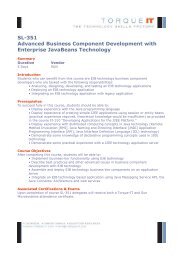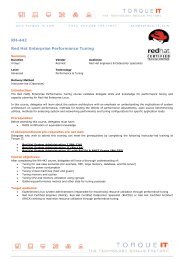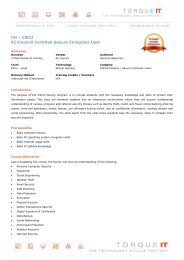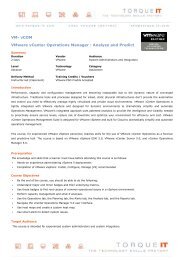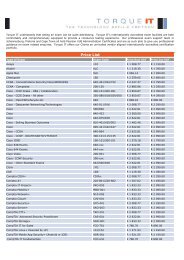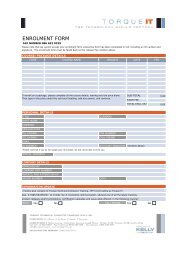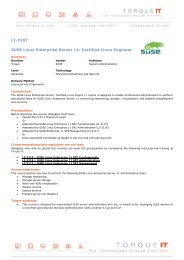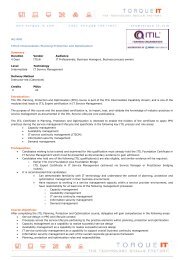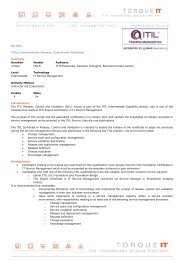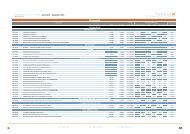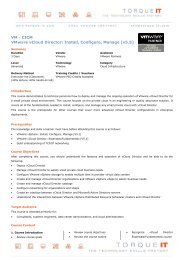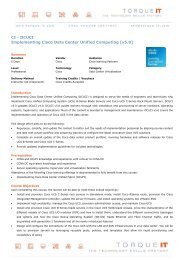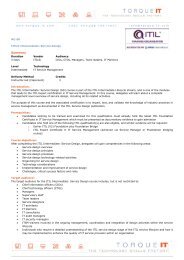CH â CHFI Computer Hacking Forensic Investigator v8.0 ... - Torque IT
CH â CHFI Computer Hacking Forensic Investigator v8.0 ... - Torque IT
CH â CHFI Computer Hacking Forensic Investigator v8.0 ... - Torque IT
You also want an ePaper? Increase the reach of your titles
YUMPU automatically turns print PDFs into web optimized ePapers that Google loves.
5. List of Special Purpose File Systems<br />
6. List of Shared Disk File Systems<br />
7. Popular Windows File Systems<br />
1. File Allocation Table (FAT)<br />
1. FAT File System Layout<br />
2. FAT Partition Boot Sector<br />
3. FAT Structure<br />
4. FAT Folder Structure<br />
5. Directory Entries and Cluster Chains<br />
6. Filenames on FAT Volumes<br />
7. Examining FAT<br />
8. FAT32<br />
2. New Technology File System (NTFS)<br />
1. NTFS Architecture<br />
2. NTFS System Files<br />
3. NTFS Partition Boot Sector<br />
4. Cluster Sizes of NTFS Volume<br />
5. NTFS Master File Table (MFT)<br />
1. Metadata Files Stored in the MFT<br />
6. NTFS Files and Data Storage<br />
7. NTFS Attributes<br />
8. NTFS Data Stream<br />
9. NTFS Compressed Files<br />
1. Setting the Compression State of a<br />
Volume<br />
10. Encrypting File Systems (EFS)<br />
1. Components of EFS<br />
2. Operation of Encrypting File<br />
System<br />
3. EFS Attribute<br />
4. Encrypting a File<br />
5. EFS Recovery Key Agent<br />
6. Tool: Advanced EFS Data Recovery<br />
7. Tool: EFS Key<br />
11. Sparse Files<br />
12. Deleting NTFS Files<br />
3. Registry Data<br />
4. Examining Registry Data<br />
5. FAT vs. NTFS<br />
8. Popular Linux File Systems<br />
1. Linux File System Architecture<br />
2. Ext2<br />
3. Ext3<br />
9. Mac OS X File System<br />
1. HFS vs. HFS Plus<br />
2. HFS<br />
3. HFS Plus<br />
1. HFS Plus Volumes<br />
2. HFS Plus Journal<br />
10. Sun Solaris 10 File System: ZFS<br />
11. CD-ROM / DVD File System<br />
12. CDFS<br />
4. RAID Storage System<br />
1. RAID Levels<br />
2. Different RAID Levels<br />
3. Comparing RAID Levels<br />
4. Recover Data from Unallocated Space Using File<br />
Carving Process<br />
5. File System Analysis Using The Sleuth Kit (TSK)<br />
1. The Sleuth Kit (TSK)<br />
1. The Sleuth Kit (TSK): fsstat<br />
2. The Sleuth Kit (TSK): istat<br />
3. The Sleuth Kit (TSK): fls and img_stat<br />
Module 08: Windows <strong>Forensic</strong>s<br />
1. Collecting Volatile Information<br />
1. Volatile Information<br />
1. System Time<br />
1. Logged-on Users<br />
2. Psloggedon<br />
3. Net Sessions Command<br />
4. Logonsessions Tool<br />
2. Open Files<br />
1. Net File Command<br />
2. PsFile Command<br />
3. OpenFiles Command<br />
3. Network Information<br />
4. Network Connections<br />
5. Process Information<br />
6. Process-to-Port Mapping<br />
7. Process Memory<br />
8. Network Status<br />
9. Other Important Information<br />
2. Collecting Non-volatile Information<br />
1. Non-volatile Information<br />
1. Examine File Systems<br />
2. Registry Settings<br />
3. Microsoft Security ID<br />
4. Event Logs<br />
5. Index.dat File<br />
6. Devices and Other Information<br />
7. Slack Space<br />
8. Virtual Memory<br />
9. Swap File<br />
10. Windows Search Index<br />
11. Collecting Hidden Partition Information<br />
12. Hidden ADS Streams<br />
1. Investigating ADS Streams:<br />
StreamArmor<br />
13. Other Non-Volatile Information<br />
3. Windows Memory Analysis<br />
1. Memory Dump<br />
2. EProcess Structure<br />
3. Process Creation Mechanism<br />
4. Parsing Memory Contents<br />
5. Parsing Process Memory<br />
6. Extracting the Process Image<br />
7. Collecting Process Memory<br />
4. Windows Registry Analysis<br />
1. Inside the Registry<br />
2. Registry Structure within a Hive File<br />
3. The Registry as a Log File<br />
4. Registry Analysis<br />
5. System Information<br />
6. TimeZone Information



